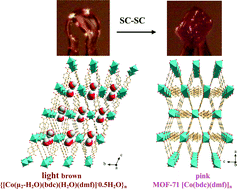MOF-71 as a degradation product in single crystal to single crystal transformation of new three-dimensional Co(ii) 1,4-benzenedicarboxylate†
Abstract
A new three-dimensional coordination polymer, {[Co(μ2-H2O)(bdc)(H2O)(dmf)]·0.5H2O}n (1), was obtained as a by-product in the synthesis of the laminar solid {[Co2(μ2-H2O)(bdc)2(S-nia)2(H2O)(dmf)]·(dmf)2·H2O}n (2) (where H2bdc = 1,4-benzenedicarboxylic acid, S-nia = thionicotinamide, dmf = N,N′-dimethylformamide). The three-dimensional network in 1 is organized of Co(II) atoms in O6 octahedral coordination environments separated by μ2-water molecules in coordination chains. The bdc2− anions coordinate in monodentate mode and also act as bridging ligands that extend the structure in two other directions. The coordination cores of two crystallographically different Co(II) atoms are completed by either two dmf or two water molecules. The rhombohedral open channels contain water molecules. The evacuation of solvents from 1 occurs as a single crystal to single crystal transformation and results in MOF-71, [Co(bdc)(dmf)]n, whose structure was confirmed by single crystal X-ray diffraction.


 Please wait while we load your content...
Please wait while we load your content...